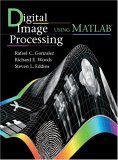Digital Image
 .:Editorial Review .:Editorial Review
Book Description
This is the first book that provides a balanced treatment of image processing basics and software principles used in the practical application of image processing. Working in the MATLAB computing environment, it provides a stable, well-supported set of software tools capable of addressing a broad spectrum of applications in digital image processing. The major areas covered include intensity transformations, linear and nonlinear spatial filtering, filtering in the frequency domain, image restoration and registration, color image processing, wavelets, image data compression, morpohological image processing, image segmentation, regions and boundary representation and description, and object recognition. For software developers working with image processing.
.:Customers reviews:
The best of its kind.
Review date: 2005-01-02 Rating: 10 out of 10
If you want to get up to speed on Matlab and plan to use it for image processing, this book is a must.
I have lots of experience in computer graphics and in programming languages like C++ and C#, but prior to reading this book I had never really used Matlab nor implemented complicated image processing algorithms. This book is a great introduction to both.
The book is divided in twelve chapters touching both low-level image processing (e.g. spatial filtering) and higher-level concepts required for computer vision, like image registration and segmentation. Gonzalez et al are talented writers, explaining relatively complicated concepts clearly and concisely, without getting lost in the mathematical details. People interested in the more theoretical aspects should (and probably already have) check their other book.
The only potential downside of this book is that it's definitely designed to be read sequentially, one chapter at a time. The matlab concepts are introduced piece by piece. For example, if you skip Chapter 5 (on image restoration, i.e. getting rid of noise) you may not realize that you missed the introduction to the image registration functions. Personally I liked this style (it added variety to a potentially dry subject), but a reader with less time to cover all of the matter may find this to be a problem. |


 .:Editorial Review
.:Editorial Review